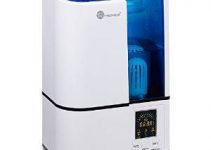Summers come and go and winter comes in replacement. For many people, the dry winter air brings about the use of a humidifier. Many people suffer from sinus and throat problems. Additionally, dry skin, dry nails, and poor hair condition can all be due to dry winter air.
A humidifier is often used to fight against dryness, especially in wintertime. Other humidifier benefits include the following:
 Can help alleviate symptoms of cold, cough, and influenza, sinusitis, allergy, nose bleeds, and even symptoms of hay fever.
Can help alleviate symptoms of cold, cough, and influenza, sinusitis, allergy, nose bleeds, and even symptoms of hay fever.- It decreases static electricity.
- It improves the quality of air in the home which may be especially beneficial for asthmatic patients.
- It alleviates and prevents dry skin, itchy skin, and dry lips.
- It keeps air hydrated and feeling comfortable.
Although humidifiers are of great benefit in the home, they may pose serious problems if not properly cleaned and maintained. Mold and bacteria can grow in the tank and eventually find their way into your home air. Cleaning and caring for your humidifier system is crucial.
How to Clean a Humidifier
Cleaning a humidifier does not require much time, and can be very simple. You probably have everything you need, including an empty spray bottle, vinegar, water, cloth, and an old toothbrush or a sponge.
First Step:
Put all your tools in one place and prep your humidifier.
Unplug the humidifier from the electric socket and then remove the filter and tank. If there is any other detachable part, remove it
Second Step:
Get an empty spray bottle and pour equal portions of vinegar and warm water.
Third Step:
If there is water in the humidifier tank, empty it and pour your prepared solution of vinegar and warm water into the tank. Allow the solution to settle for about five to ten minutes. Next, get your sponge, old toothbrush, or cloth to scrub any mineral deposits that remain. Rinse the tank thoroughly.
Fourth Step:
Put vinegar into the humidifier base and allow it to settle for about forty-five minutes. Then, as usual, use your cleaning tool (an old toothbrush or cloth), and scrub the base thoroughly to remove any foreign particles. These are the ones that cause mold and bacteria. YUCK!
Try to repeat steps one through four every three days when you are actively using your humidifier.
Fifth Step:
Consider cleaning or changing filters, if your humidifier uses one. Some people prefer to buy new filters rather than clean them.
How to Clean your Humidifier Filter
- Mix together equal parts vinegar and water into a big container that can fit the filter. Allow it to soak for up to 45 minutes to one hour.
- Thoroughly check the humidifier filter for dirt and mineral deposits. If you still notice traces of particles, put it back into the mixture.
- Finally, rinse the filter with water and let it dry completely.
Filters that are dirty affect a humidifier’s performance negatively. For the effective performance of your humidifier, check filters regularly. Be prepared to add it to your list of regular chores. If you’re using hard water for your humidifier, you will have to clean the filters more often.
Sixth Step:
After following the above steps to clean the humidifier, you can sanitize the humidifier by adding a 3 percent hydrogen peroxide composition.
Other important tips for keeping a clean humidifier
If it is possible, try using distilled water because it has fewer mineral particles than your tap water.
Even though a humidifier is very beneficial to healthy living, it can create an ideal environment for mold and mildew if not properly maintained and cared for. Following the basic steps above can help you enjoy the benefits of a humidifier for a long time to come.
Have you read through the 10 benefits of humidifiers? If not, consider reading so as to enlighten yourself about humidifier uses. Or, you can visit our humidifier reviews and guide


